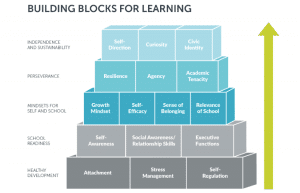#iNACOL16 Day Three Learnings on the Run
CompetencyWorks Blog
Well, actually, I’m not running anymore. I was able to catch my breath for the weekend before I head out to District 51 in Grand Junction to learn about their early stage implementation.
Here are some of my highlights from the final days of iNACOL16:

Productive Struggle: One of the reasons I think so highly of the Matchbook Learning team is that they are always trying to figure out how to meet the needs of students who have large gaps in foundational skills or are on a performance level that is below their grade level. (I apologize for the use of a deficit structure, but we still haven’t figured out a way to talk about students being at different levels that doesn’t use the grade level as a norm.) Sajan George described that they have concerns that leveling students and offering instruction that meets them at this level is not working the way they had hoped. Yes, it helps students build all the foundational skills they need, but it isn’t building other skills – specifically the skill and traits needed to productively struggle with challenging problems. One might think about it as the ability to apply learning, not just demonstrate the skills. Application requires us to think about which skill or approach can be helpful.

Later that same day I had a chance to meet Dixie Bacallao from reDesign. How to design for productive struggle was one of the many things we touched on. She cautioned that it is important to take into consideration where students are in their own learning and development (including social-emotional learning and relationships with peers) and how big the gap between performance and grade level is in designing interventions. In other words, there is no single best intervention.
She described one approach that one of the high schools she is working with is going to try out for students who have reading levels at fifth grade or below, referred to as 30-30-30-10.
The instruction is going to be very intentional, with:
- 30 percent at grade level so students can build fluency and have the experience of purely enjoying reading.
- 30 percent will be reading at levels somewhat above their reading levels. This might be considered a stretch level with students building their skills in annotation and close reading.
- 30 percent of the time teachers will read aloud complex text. This provides students the chance to use their brains to think about big concepts even if they would have great difficulty reading the text.
- 10 percent of the time is dedicated to reflection and goal setting, basic building blocks in building agency.
I’m collecting more stories about the different types of interventions that are being used. Please send me your best intervention for students with gaps or not on-track to graduation.
 Solving the Big Problems: In his morning keynote, Jim Shelton, director of the Chan Zuckerberg Initiative’s education efforts, reminded us that the traditional system is built around the concept of the bell curve: some students have it and others don’t. This means that the system has inequity built into its very core – and inequity leads to inequality. But we know from research that it doesn’t have to be that way. Our challenge is to figure out how to provide the quality of education that is equal to 1:1 tutoring – i.e., personalization – in a way that is efficient.
Solving the Big Problems: In his morning keynote, Jim Shelton, director of the Chan Zuckerberg Initiative’s education efforts, reminded us that the traditional system is built around the concept of the bell curve: some students have it and others don’t. This means that the system has inequity built into its very core – and inequity leads to inequality. But we know from research that it doesn’t have to be that way. Our challenge is to figure out how to provide the quality of education that is equal to 1:1 tutoring – i.e., personalization – in a way that is efficient.
Shelton walked us through ways for us to think about how to have more impact and more scale. One part of this is to ensure that we are bringing in the best expertise we can, including learning science engineers. However, he is not suggesting that any one expert has all the answers. In fact, he introduced Cantor’s Building Blocks for Learning as a framework that takes into account child/adolescent development and the emotional well-being of children (including trauma that can impact learning). Repeatedly, Shelton reminded us that we need to think about broad understanding of what student success looks like – not just passing reading and math tests. (I’m thinking that CompetencyWorks might want to adopt these building blocks. What do you think?)
Shelton also raised a number of big issues we have to solve. How do people learn and achieve mastery (taking into account neurological/biological, cognitive, behavioral sciences)?
- How do we better identify and describe what people need to learn?
- How do we less intrusively and more flexibly and accurately assess and enable validated demonstration of learning progress and mastery?
- What learning experiences most efficiently produce mastery – for whom and in which contexts?
- How do different delivery methods effect learning and mastery? How can the efficacy and efficiency of each be maximized?
Some of them we’ve been talking about on CompetencyWorks but not as directly or as deeply as these questions demand:

Is CBE More Constructivist and Blended/Online Learning More Behaviorist? If So, are There Implications for Design and Implementation? Julia Freeland Fisher from the Christensen Institute was the first person who mentioned the possibility that competency-based schools may be more likely to be using constructivist approaches to learning, whereas in online learning, a behaviorist theory of learning is at work. Now, these are not terms I use in my vocabulary, so understanding this included follow-up conversations with Fisher and reading resources on the web. However, in a conversation with Wayne Poncia of Hapara, he also mentioned behaviorist approaches in blended classrooms. He suggested that transparency can feel reduced in the blended classroom, as students are interacting with educational software and productivity tools and teachers aren’t able to quickly see the processes (they can of course get tons of data from the software programs). So teachers try to get a handle on this by becoming more controlling and monitoring behavior. Hapara is a tool that seeks to increase transparency and create more collaborative tech-rich classrooms.
Now, I tend to always return to the ideas of balance – and it is likely that any teacher uses a mix of constructivist and behaviorist approaches. However, student agency is a critical component of competency-based education as well as an outcome. Students need to be able to manage their own learning processes, strategies need to be used to build intrinsic motivation, and students need to be able to create their own meaning through a variety of skills. Blended learning is, of course, a combination of instructional delivery methods – thus perhaps the lesson here is that we need to make sure the face-to-face instructional time (as compared to the online delivery of instruction) needs to be designed using constructivist approaches and very intentional strategies to build agency, intrinsic motivation, and inquiry.
See also:
